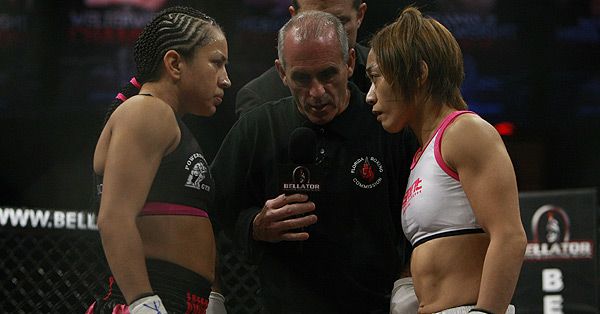MMA history is rich with incredible action and talented individuals who have left their marks. The Defining Moment will provide in-depth looks at some of the sport’s greatest and most important junctures featuring the women who have paved paths to where they are today.
What is a “Bellator”?
Countless MMA fans still might not be able to answer that question despite one of the sport’s premiere promotions existing for 15 years and counting.
In Latin, a “Bellator” is simply put: a warrior. Bellator in MMA, however, became a new opportunity for an assortment of talented fighters seeking history to make in 2009. The term has been synonymous with the sport ever since.
The promotion wasted no time standing out from the other North American MMA giants like UFC and Strikeforce by focusing on tournament-based fight cards, where fighters competed throughout several events to earn title shots. In a way, that fact only makes PFL’s acquisition of Bellator in late 2023 all the more poetic, but we’re not to that part of the story yet.
In terms of inclusivity, Bellator wasn’t shy to try new things in more areas than one as they quickly got female fighters into the mix. At the time, women were still breaking through the wall of visibility in North America and yet to reach the UFC, which inevitably came in 2013. Before that, Bellator and Strikeforce acted as key platforms for several future champions and legends of MMA.
“I was actually the first female fight in Bellator, so that was really cool,” said Jessica Penne, who earned a first-round TKO over Tammie Schneider at Bellator 5 in May 2009. “I was on the same card as when Toby Imada inverted triangled [Jorge] Masvidal. It was so cool to be there.
“Fighting in Bellator was just a huge step up. It was an exciting time because that was again, another platform that they were giving females an opportunity to really showcase our skills. It just showed that we were being taken seriously and that the sport was growing, that we were growing, and it was really exciting. To be a part of that tournament I just remember being really nervous again because it was such a big deal that women were really cutting a lot of weight and I just remember being excited and nervous, but then I realized that’s when I was going to go down to 105 because if people were cutting that much weight to be successful in that weight class then I was going to be the start doing the same.”
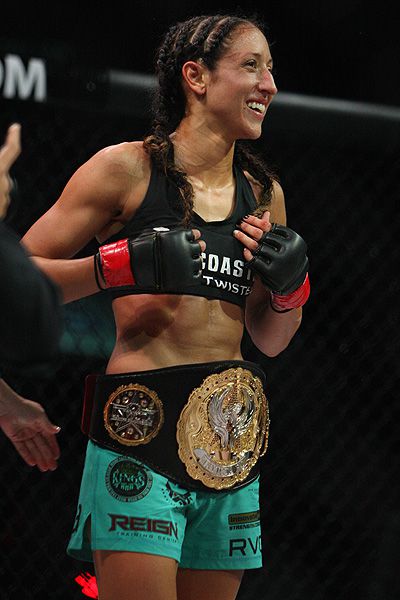
Dave Mandel (Sherdog)
For several fighters, Bellator gave them not just a good burgeoning platform of exposure, but one that aided in finding their proper weight classes. In the case of Penne, 115 has been the primary division for her career. Her peak success came as an atomweight when she won Invicta FC gold in 2012, a dream she realized two years post-Bellator.
Strikeforce had started honing in on the heavier weight classes of bantamweight and featherweight for women. That allowed Bellator to spotlight flyweight and strawweight ... or at least try to. Weight management and finding a stable home, specifically within an organization, was arguably the story of Rosi Sexton’s 18-fight career.
The well-educated British pioneer joined the Bellator roster after stints in Cage Warriors and Bodog. It was a nice progression to see something new, but the growing pains were blatant.
“It definitely felt like that was a step forward,” Sexton said. “Bellator was frustrating. There were a bunch of fights that were supposed to happen but didn’t. I still slightly regret that some of those didn’t happen, I think they would have been good fights. But I remember I trained for Jessica Aguilar twice and they never came together in the end. It is what it is, I don’t think it was necessarily anyone’s fault in particular. Stuff happens.
“I was going through sort of a lot of upheaval at the time in my personal life. I’d split up with my partner who was also my coach, and I tried to put a bit of training camp together — that was around the time that Bellator was going to do the tournament. Obviously, that didn’t really go to plan. That was when I realized again, I needed to make some changes.”
Bellator truly got its metaphorical feet wet with the women when it hosted a handful of fights in the launch year. Names like Sexton, Penne, Aguilar, Carla Esparza, and Megumi Fujii helped jumpstart the possibility of a tournament. There could only be one set of an ultimate eight and to get there, there was a curveball. Her name was Zoila Frausto.
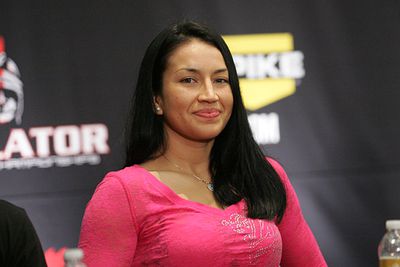
Sherdog (Keith Mills)
“She only ever made 115 for that time and she actually did a number on her body and I remember hearing around the community that it really messed up her system trying to make that weight,” Penne said. “But I mean, it was a huge opportunity so I don’t blame her, you know? It was a great opportunity for any woman. So, I totally understand the desire to really just step up and get in there like that.”
Frausto debuted as part of the roster opposite Sexton at Bellator 23 in June 2010 — her fourth fight that year and first south of 125 pounds as the contest was a 121-pound catchweight. Bellator was still sorting out the combatants for its eight-woman strawweight title tournament, which was supposed to include Sexton.
A 26-year-old Frausto was on a one-fight deal and viewed as nothing more than a warm-up for her British counterpart. She debuted as a pro in February of the previous year. With nothing to lose, the “Warrior Princess” only needed two minutes to score a knockout with a knee and punches.
The win ultimately acted as Frausto’s version of a golden ticket into the tournament despite no fights fought at strawweight.
“I was walking around at 145 so having to cut all that weight every four to six weeks, every month, was probably the hardest thing I’ve ever had to do,” Frausto said. “I dealt with so many medical issues after that. I couldn’t get below 145 after that. I was cutting weight to grapple in tournaments. I had a lot of issues.”
Circling back to the relation between early Bellator and PFL, the latter likes to boast about the difficulty of its regular and post-season format, which is fair. To win the million-dollar prize each year, a fighter needs to win five fights within an eight-month window. In the modern-day, two fights a year is the comfortable average, and champions at the highest level rarely fight more than that.
Early Bellator was on a different level, especially if you were fighting down.
The Bellator strawweight title tournament started in August 2010 where Frausto won her opening round matchup against the aforementioned Penne by unanimous decision. From there, she fought each of the following two months to score colossal split decision upsets over pound-for-pound elites Jessica Aguilar then Megumi Fujii in the championship final.
That was that for Frausto as a strawweight in Bellator. She made her history, was dealt some injuries, and the division controversially faded out of sight. Critique of the Fresno, Calif. native has been commonplace ever since, highlighting Frausto’s supposed size advantage and questionably judged victories against her final two tournament opponents.
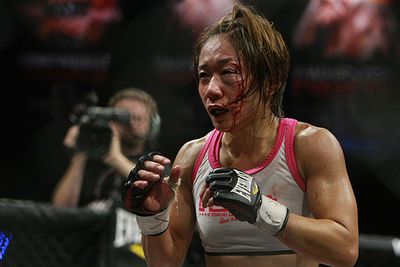
Dave Mandel (Sherdog)
“It was great, it was awesome,” said Megumi Fujii’s coach and former UFC heavyweight champion Josh Barnett of seeing Bellator spotlight women. “To me, it was the thing that we were working towards. The one big opportunity that could really propel her (Fujii) and it was really, really heartbreaking for her to lose in the finals.
“Zoila, she doesn’t suck, she’s not a terrible fighter, and she went out there and gave it her all as well. But I was so upset also because I’m like, ‘Okay, one person’s an actual 115-pounder, the other one managed to just do it enough to get their opportunity and then was going to leave anyways.’ So to me, I’m like ah, no … And then the person that came to just raid the tournament has won and they’re gonna take off and never defend the belt, never do anything with it, and they’ll disappear and it won’t matter as much. It’ll dampen the whole thing — not really push the overall paradigm for the women. Which, obviously, Zoila wasn’t considering any of those types of things and she was out there getting her own. I’m sure she didn’t intend for the results of that tournament to fade in a way and fizzle over time the way that it did. I’m sure she had no intention for that. So, this is not me casting aspersions upon the other athlete at all.”
Fujii’s loss to Frausto was one of the more controversial in MMA history and the fact that it was the record-setting 22-fight win streak snapper of a loss only soured everything even more. That was for everyone but Frausto, of course, who exceeded her expectations beyond belief.
It’s mostly a blur for the inaugural champion as she recalls her sister telling her she’d regularly pass out during weight cuts and would wake up crying.
“Everyone I fought was way more experienced than I was,” Frausto said. “By the time I had won that tournament, I had been fighting professionally for 18 months. Within that short amount of time, I had so many fights, cut so much weight, fought a lot of the top women in the world, and I honestly don’t even know how I did it.
“I remember waking up for that last fight against Megumi Fujii, trying to make that weight at 115, I had trouble that entire tournament every single time because I would blow up to my natural weight of 145. I was traumatized. Going into saunas after that, fighting any time after that, it was bad. I honestly don’t remember a lot of it.”
Divisions for women were one of their biggest hurdles before the sport evolved to where it is now. Had Frausto been afforded the ability or choice to make flyweight her main fighting home, she would have, as Penne, Sexton, and Fujii would have done the same with their respective optimal classes at atomweight and strawweight.
Bellator believed the middle ground to create the best talent pool was strawweight, and that specific opportunity was just too new and great to pass up.
“There was no other option,” Frausto said. “It was, ‘This is what we have. It’s a world tournament at 115,’ and at that point in time, that was the biggest, baddest [division]. It was like, okay, well, I don’t really have any other options but to fight at 125 or 135 for Strikeforce and that was in my natural weight class. When I fought Miesha Tate at 135 that’s when I realized, okay, I don’t have wrestling, I don’t have jiu-jitsu, and obviously, I don’t know what the hell I’m doing. So, I need to figure out what my weight class is and that’s when I got the call from Bellator for 120. I had never made that weight but f—k it, let’s do it (laughs).”
Do it she did. Frausto still never felt flyweight was necessarily her optimal weight class despite being the healthier alternative. After her title win, she returned in March 2011 at 125 pounds to win a unanimous decision against Karina Hallinan. She’d be out until October 2012 afterward, and go 1-1 to close out her Bellator run with a Casey Noland win and surprise 58-second standing arm-triangle choke loss to Jessica Eye.
Fujii, on the other hand, went back to Japan to rattle off three straight wins before one final fight in the Bellator cage. “Mega Megu” always fought to prove women were as talented and capable as the men in MMA. A title on top of her career to that point would have, in theory, been an ultimate catalyst for female fighters before what came in 2013 in UFC.
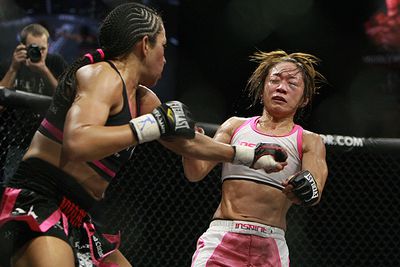
Dave Mandel (Sherdog)
“I saw it as not only a big opportunity for Megumi but I felt that Megumi winning would have really done something on a bigger global scale for women’s MMA than Zoila,” Barnett said. “But nobody has to go out there and let someone else win. I mean, to hell with that. For us, it was that we needed to do a better job and there were some things … the gameplan was not followed fully, so things went the way they went. I still think that fight was at worst a draw, but you gotta go out there and take your opponents out if you don’t want bad decisions to be a potential.
“It’s heartbreaking from my perspective but I can’t sit back and nitpick the judges or even bring anything about Zoila being at fault for anything. I really look at it as it’s on us, but at the end of the day, it would have been massive and that’s actually more of what Bellator was expecting but it is what it is and it was still a great opportunity and it was great money for Megumi. She got some publicity from being on television, which was great, but as we still sit here today, people still act like anything that happened prior to five years ago happened. If Paige VanZant and Ronda Rousey, the more notable names aren’t mentioned, then women’s MMA didn’t exist. That’s not the fault of any one of the athletes who are popular or become popular, it’s a cultural issue of this modern era.”
Unknown at the time, Barnett revealed that his fighter was hampered by a herniated disc in the historic battle. Ultimately, Fujii never complained or made any big excuses for the outcome of her first career loss.
In her biographical story we worked on together in 2020, Fujii admitted she concluded that she was never ready to be champion. More specifically, she was “scared” of how life would and could change. A finisher through and through, everything added up to take a toll on the legend’s mind, as she’d only won by decision thrice in her 22 prior fights.
“There’s a lot of opinions about that decision and I hear many things about that fight and that decision but at the very end of the day, it was my fault,” Fujii said. “I wasn’t 100 percent mentally. My mentality going into that fight was not right.”
Frausto too had a mental battle, and the weight lifted from a once-in-a-lifetime type of physical strain. A sense of accomplishment and overcoming such insurmountable odds will forever be something that can’t be taken away from her.
In MMA history, Frausto is the first strawweight champion ever in a major promotion. When all is said and done, she may very well end up being Bellator’s first and only, too.
“It really was a huge weight off my shoulders,” Frausto said of the title win. “I’ve never worked so hard in my life for anything and I think just to get to that point because I wasn’t supposed to be in that tournament. I wasn’t supposed to make it past the first girl or the second girl. Especially not Megumi Fujii.
“I remember people just talking about how great all these fighters were and they had been around for years at that point in time. I was brand new to this scene. I’d maybe been training Muay Thai for less than a year. Never had any jiu-jitsu, never had any wrestling, I was just an athlete. Being a part of that and actually going in there and people were not happy about it. I still remember to this day that was a huge thing. Everybody was super upset because it wasn’t the way it was supposed to go. Megumi Fujii was supposed to win that, especially going 22-0. It was a great feeling. I felt like I was on top of the world and at that time, I was.
“People can continue to talk s—t for however long, but the way it ended was the way it was supposed to. I made it,” she continued. “I made it through, I got to those fights, I fought those fights, none of them finished me. They were all way more experienced than I was. Bigger, stronger, whatever it is, I’m sorry. I still made it and my hand was raised at the end of each one of those.”
It took Frausto a while not to dwell on some of the backlash that came her way. With everything considered, it was only a matter of time before she realized she never had to prove anything to anyone. Constantly dehydrated for the entirety of the tournament, she was reminded after each fight what she was doing to herself by seeing the damage produced on her face.
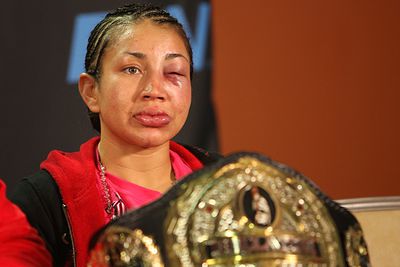
Dave Mandel (Sherdog)
From Bellator’s perspective, the plan was supposed to hold. Frausto was going to be a defending champion, there was clear potential for sequels to the tournament bouts, it simply all made sense to maintain — even if she was unable to uphold it for a lengthy period.
Had the promotion and those in charge been serious with long-term strawweight intentions, you’d have to think they could have just carried on and done Fujii vs. Aguilar 1 for vacant gold.
“The plan was to fight again at 115 because they wanted to see that Aguilar [rematch],” Frausto said. “They wanted to possibly see that Megumi Fujii [rematch] and that’s what we were gonna do. Then I tore my ACL. So, coming back after that, that’s when they said they would offer 125 to I believe Aguilar. Something about her not taking it at 125, or she said yes then she said no, I don’t know exactly what the true answer to that is. Then our plan was to drop back down to 115 and fight again but by the time all that came to, they just completely got rid of the women’s division.
“I just have a sour taste in my mouth about that. [Bellator Founder] Bjorn Rebney promised the world and he did not deliver on any of it. When it came to Bellator, at the end when it all fell apart, I was like, ‘I don’t want anything to do with this promotion anymore.’”
Unfortunately for all the fighters involved, that was it in Bellator. It was goodbye from there as they moved on without a division and committed organization, as Rebney carried about business through a sale to Viacom in 2011 until he was replaced by Strikeforce’s Scott Coker as president in 2014.
Coker provided a clear blueprint in Strikeforce for his predecessor and it had a nice attempt followed with some spins to it. When the going got tough, it took for Coker to pick up the pieces, which led to the revitalization — or perhaps the start of stability — for female divisions in Bellator.
Featherweight — a division Coker almost solely helped spotlight — was immediately introduced into the fold upon his arrival, and featured stars from Strikeforce who were unable to make 135 pounds through the UFC absorbing Strikeforce. One year later, the flyweight division was brought into the fold and given a proper run that’s gone on strong ever since.
“I met Scott Coker quite soon and Scott is a martial artist so he can relate to you and you can relate to him and he understands martial arts like no one,” said former Strikeforce bantamweight champion Marloes Coenen. “For me, it was like a big dream because, in Japan, the market had declined. It felt to me like the next big step I was waiting on for a very long time.
“It felt the same as Strikeforce [in Bellator] because the same vibe was back. And of course, you come in to fight and you get your money, that’s good. But it’s nice if people actually care for you as a fighter and that’s what they do at Bellator.”
“I’ve pretty much accomplished everything that I didn’t even know I wanted to accomplish in terms of my MMA career,” said inaugural Bellator flyweight champion Ilima-Lei Macfarlane. “So, cool. Time to move on, time to pass the crown on, let somebody else have their dreams and achieve their dreams. Everybody wants to win, and everybody wants to be champion (again). I feel like I’ve already cemented my legacy and I’m okay with that.”
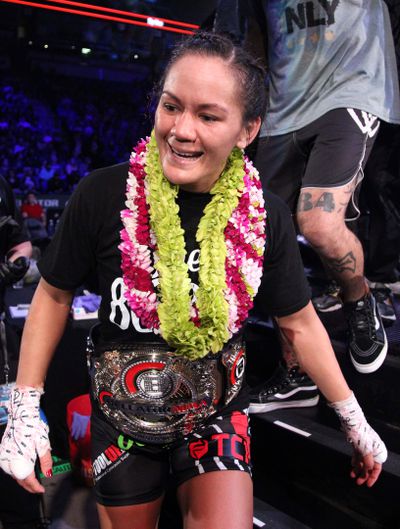
Matthew O’Haren-USA TODAY Sports
It’s a night and day difference from 2010 to 2024 with options promotionally and divisionally. History is always finding ways to repeat itself, however. Hence PFL’s recent acquisition of Bellator.
The tournament and season-based fight league has featured lineups at lightweight, featherweight, and flyweight for women throughout its young run thus far. In 2024, flyweights will receive the primary focus while Bellator titles live on somewhat separately but still under the same overall umbrella.
It’s all about growth and evolution in MMA. Things started with Frausto and the strawweight bracket in Bellator, and thankfully, they didn’t end there.
“I’m so f—king proud of what the women are showcasing in the cage. It’s only getting better,” Coenen said. “Look at Rose Namajunas and all those amazing fighters. It’s wonderful. To think where I started with the first real world championship in Japan, the year 2000, the level of competition to now, it’s a quantum leap. It’s fantastic and I’m so curious to see where we are in 10 years. How good will the women be then?”
PFL vs. Bellator takes place in Riyadh, Saudi Arabia inside the Kingdom Arena this weekend (Sat., Feb. 24, 2024).
For all the latest PFL and Bellator MMA news and notes click here and here.
N'oubliez pas de consulter les prochains événements sur notre calendrier de l'UFC.

